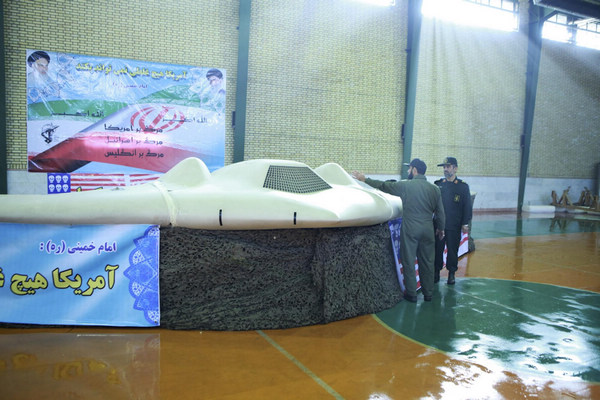Iran says it captures drone; US denies losing one
(Agencies) Updated: 2012-12-05 09:12DUBAI - Iran said on Tuesday it had captured a US intelligence ScanEagle drone in its airspace over the Gulf in the last few days, but the United States said there was no evidence to support the assertion.
The US Navy said had not lost any unmanned aircraft in the area. The four-foot (1.25 metre) surveillance drones built by Boeing Co are deployed in the region by the United States military and also by other countries.
In Washington, White House spokesman Jay Carney said: "We have no evidence that the Iranian claims are true."
The incident highlighted tensions in the Gulf as Iran and the United States demonstrate their military capabilities in the vital oil exporting region in a standoff over Iran's disputed nuclear programme.
Iran has repeatedly threatened to close the Strait of Hormuz - through which about 40 percent of the world's seaborne crude oil is shipped - if it comes under attack. US commanders have said they will not let that happen.
The Islamic Revolutionary Guards Corps said on its website that the drone had been flying over the Gulf in the last few days and was "captured" when it strayed into Iranian airspace.
A spokesman for US Naval Forces Central Command in Bahrain said none of its drones were missing.
"The US Navy has fully accounted for all unmanned air vehicles (UAV) operating in the Middle East region. Our operations in the Gulf are confined to internationally recognised water and air space," Commander Jason Salata said.
The ScanEagle is an "off the shelf" spy plane manufactured by Insitu, a unit of US-based Boeing. The company also supplies and operates drones for customers in several Middle Eastern countries, including to help ensure oil platform security in the Gulf, according to its website.
The US military has been using the ScanEagle spy planes since 2004 and they have become a relatively inexpensive way for the United States and others to conduct surveillance.
Jill Vacek, a spokeswoman for Boeing subsidiary Insitu, said the company had built 1,685 of the aircraft. Other military customers include Canada, Australia, Poland, the Netherlands, Singapore, Malaysia, and Japan, as well as "other US Department of Defense customers," she said.
One year ago, the company also announced an alliance with an Abu Dhabi-based company to support ScanEagle and other unmanned vehicles in the Middle East.
Iranian Foreign Minister Ali Akbar Salehi said Iran had warned the United States over its violations, and would use the drone as evidence of American incursions to pursue its complaint "via international bodies", IRIB News reported.
The IRGC statement did not specify when or where the drone was found, nor whether it was shot down or crashed. It released what it said was video of an apparently undamaged ScanEagle being examined by uniformed officers beneath an English-language sign reading "We shall trample on the US"
The incident is the latest in a string of complaints by Iran over what it says are US violations of its territory in an often clandestine conflict over Tehran's nuclear programme that has featured assassinations, espionage and cyber sabotage.
Iran and OPEC rival Saudi Arabia have also accused each other of violating each other's territory near oil and gas fields in the Gulf over the past year.
VIOLATIONS
In what a spokesman insisted was a coincidence, the US Navy posted a news release on its website on Tuesday boasting about a new Puma AE airborne surveillance drone being tested aboard ships of its 5th Fleet, based in Bahrain.
"High overhead, rain or shine, an elusive, yet sophisticated surveillance equipment flies in areas that are difficult to see with the naked eye," the statement said of the lightweight high-winged monoplane.
In November, the United States said Iranian warplanes shot at a US surveillance drone flying in international airspace. Iran said the aircraft had entered its airspace to spy on Iranian oil platforms and said it would respond "decisively" to any incursions.
Days later Iran's ambassador to the United Nations, Mohammad Khazaee, wrote to Secretary-General Ban Ki-Moon to complain about what he said were repeated US violations of Iranian airspace, describing them as "illegal and provocative acts".
Khazaee said that US craft had entered southern Iran seven times in October around Bushehr where Iran's only nuclear power station is situated.
A year ago to the day, Iranian forces announced they had captured a US RQ-170 reconnaissance drone in eastern Iran which was reported lost by US forces in neighbouring Afghanistan.
Iranian commanders have since announced they have extracted valuable technology from the aircraft and were in the process of reverse-engineering it for their own defence industry.
The United States and its allies believe Tehran is trying to develop nuclear weapons and have imposed tough economic and financial sanctions. Iran says its programme is purely peaceful.
Israel has threatened to bomb Iranian nuclear sites if diplomacy and sanctions fail to stop its nuclear activities, and Washington also says a military option is on the table. In October, Israel shot down an Iranian-made drone launched into the Jewish state by Lebanese Islamist group Hezbollah.
According to Boeing's publicity material, the ScanEagle drone can be launched by a catapult from mobile vehicles or small ships, making it independent of runways.
It can fly pre-programmed or operator-run missions guided by navigation satellites and its onboard flight control system. It is retrieved using a "Skyhook" system in which the drone catches a rope hanging from a 50-ft (16-metre) high pole.








